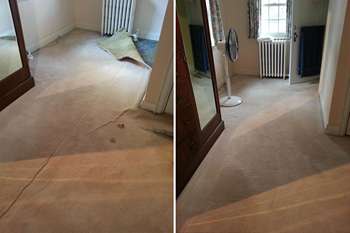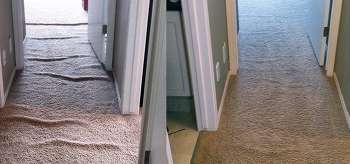4 Reasons Your Carpet Ripples, Waves & Bumps
Top Reasons:
- Moisture – Carpet is made up of two layers that react differently when exposed to moisture. If carpet is continually exposed to excessive moisture, or high humidity, you may have problems. Caution is required when cleaning your carpet by hot water extraction (steam cleaning), and we recommend using professional certified cleaners.
- Defective carpet or underpad – Products are not always made perfect. The truth is the formula in the carpet backing may vary from one roll to another, or even from the beginning of a large roll to the end of a roll. (The color as well will vary slightly from the beginning of a roll to the end.)
- Improper installation or improper acclimatization – A poor installation could be the cause. A carpet installed in a cold house in the winter will not likely be stretched as well as a carpet on a hot summer day. Manufacturers recommend acclimatizing the carpet in the house, as well as the use of a power stretcher when installing.
- Uneven surface beneath the carpet – Uneven joints in the sub-floor will likely telegraph through the carpet. As well, carpet underpad may have less density from one side of a roll to the other. When uneven densities of underpad join at a seam, the result could be rippling down the road. For a lasting solution you will need to fix this underlying problem.
What is a Power Stretcher?
 A power stretcher is a tool used to stretch carpet during installations and carpet ripple repairs. Simply stated the large arm is pressed down which in turn extends the head away from the power stretching body. The head of the power stretcher has teeth that grip the carpet and transfers the stretching force.
A power stretcher is a tool used to stretch carpet during installations and carpet ripple repairs. Simply stated the large arm is pressed down which in turn extends the head away from the power stretching body. The head of the power stretcher has teeth that grip the carpet and transfers the stretching force.
In the picture you can see the silver stretching tubes, these are set up behind the stretcher to push off of the opposing wall to anchor the power stretcher. Depending on what type of substrate is underneath the carpet (usually wood or concrete) different attachments can be used. On concrete, power stretching tubes are basically your only choice and require moving the furniture in order to get straight lines from one end of the room to the other. However, over wood sub-floors, there is another attachment that can be used (without poles) which minimizes the space needed, and therefore requiring less moving of furniture.
There are other power stretching tools being used and manufactured, but this is by far the most common and effective.
Photos of Re-Stretching Before & After






